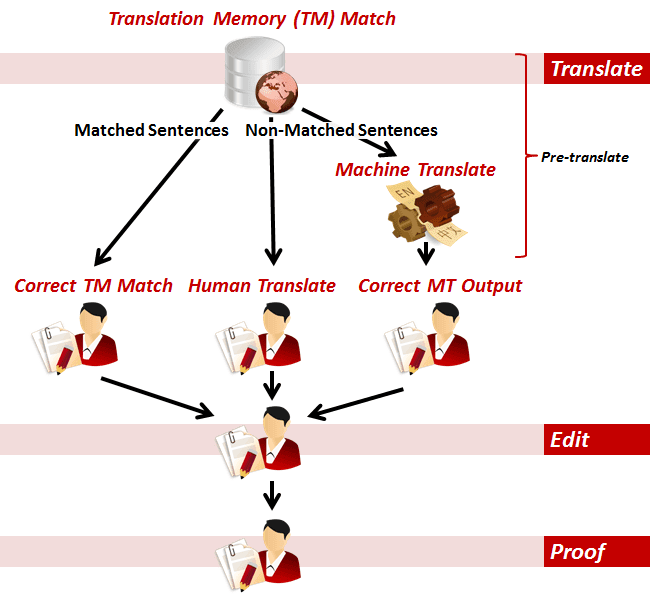How does Machine Translation fit into my translation workflow?
Language Studio is integrated with the leading Translation Memory Systems, Translation Management Systems, and Content Management Systems – leading to seamless workflow integration. APIs are freely available for integration with other third-party platforms.
Language Studio is designed to integrate at the pre-translate stage, immediately after or as part of the same stage where translation memories are matched to the source text being translated. Integrating at this early stage means that the existing translator workflow does not change and is almost identical to post-editing a translation memory fuzzy match.
Example Integration of Translation Workflow Integration

Options:
Option 1: Translate via your preferred TMS
- Perform a translation memory match within your preferred TMS platform.
- A typical fuzzy score of 85% or greater is used as raw MT will often be better than a lower scoring fuzzy match.
- Send unmatched segments to machine translation. TMS platforms integrated with Language Studio can do this as a single click or automated immediately after the translation memory match.
Option 2: Edit and Proof using your preferred editing tools
- Depending on the quality or the MT output, raw MT output can be corrected by a translator or, in the case of high quality MT, can often bypass this translator step and go directly to an editor.
- Language Studio confidence scores can be leveraged to determine whether segments should be reviewed by a translator or an editor.
- Different projects have different budgets and quality requirements. This should be taken into account when defining the workflow for a project.
- After editing and proofing, the high quality segments for a given project can be applied to the custom machine translation engine so that next time it is use, the lessons learned from these edits will be applied, raising quality of future translations. This is usually just prior to publication.
Related Links
Pages
- Introduction to Machine Translation at Omniscien
- Hybrid Neural and Statistical Machine Translation
- Custom Machine Translation Engines
- Powerful Tools for Data Creation, Preparation, and Analysis
- Clean Data Machine Translation
- Industry Domains
- Ways to Translate
- Supported Languages
- Supported Document Formats
- Deployment Models
- Data Security & Privacy
- Secure by Design
- Localization Glossary - Terms that you should know
Products
- Language Studio
Enterprise-class private and secure machine translation. - Media Studio
Media and Subtitle Translation, Project Management and Data Processing - Workflow Studio
Enterprise-class private and secure machine translation.
FAQ
- FAQ Home Page
- Primer; Different Types of Machine Translation
- What is Custom Machine Translation?
- What is Generic Machine Translation?
- What is Do-It-Yourself (DIY) Machine Translation?
- What is Hybrid Machine Translation?
- What is Neural Machine Translation?
- What is Statistical Machine Translation?
- What is Rules-Based Machine Translation?
- What is Syntax-Based Machine Translation?
- What is the difference between “Clean Data MT” and “Dirty Data MT”?

